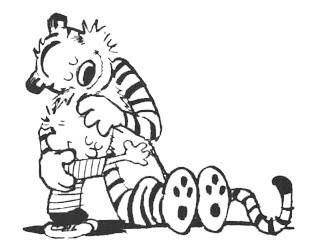 No, this doesn’t refer to a theologian and a philosopher, but a six-year-old curmudgeon and his stuffed tiger. Chances are, if you are under 30 you sadly may have never heard of the Bill Watterson comic strip, one of the most influential, entertaining and groundbreaking of the genre. Tomorrow (Tuesday, March 10) a retrospective book is being published, which grew out of an exhibition at the Billy Ireland Cartoon Library & Museum at Ohio State University that ran in 2014. (Did you know there was a cartoon library and museum? I didn’t either.)
No, this doesn’t refer to a theologian and a philosopher, but a six-year-old curmudgeon and his stuffed tiger. Chances are, if you are under 30 you sadly may have never heard of the Bill Watterson comic strip, one of the most influential, entertaining and groundbreaking of the genre. Tomorrow (Tuesday, March 10) a retrospective book is being published, which grew out of an exhibition at the Billy Ireland Cartoon Library & Museum at Ohio State University that ran in 2014. (Did you know there was a cartoon library and museum? I didn’t either.)
 Christopher Caldwell writes about this and the comic strip in a Wall Street Journal piece, the title of which many would agree with: “‘Calvin and Hobbes’: America’s Most Profound Comic Strip.” Here is a brief intro from Caldwell, for those not familiar the world of ‘Calvin and Hobbes’:
Christopher Caldwell writes about this and the comic strip in a Wall Street Journal piece, the title of which many would agree with: “‘Calvin and Hobbes’: America’s Most Profound Comic Strip.” Here is a brief intro from Caldwell, for those not familiar the world of ‘Calvin and Hobbes’:
In 1985, American newspaper readers met an appalling little boy. He taunted his mother (“Prepare for annihilation, pitiful Earth female”), tormented a classmate by telling her he had brought a “thermos full of phlegm” for lunch and kept a sign on his bedroom door that read “Enter and die.” Millions fell in love with him.
Running in hundreds of papers for the following decade, Bill Watterson ’s “Calvin and Hobbes” was not only the strangest American comic strip. It was also the funniest, the most touching and the most profound. . . .
At its simplest level, the strip is about the friendship between a bright 6-year-old misfit (Calvin) and his pet tiger (Hobbes). Its “trick” is that Hobbes is a lifeless stuffed animal when others are present and a rollicking, witty companion when they are not. So the story can be understood on many levels. It is about the richness of the imagination, the subversiveness of creativity and the irreconcilability of private yearnings and worldly reality. Where Calvin sees a leaf-monster trying to swallow him, Calvin’s father sees his troublemaker son scattering the leaf-piles he has spent all afternoon raking.
 For those who loved “Calvin and Hobbes” it was a sad day in 1995 when we learned that Bill Watterson was hanging it up and retiring; he was only 35. But the strip lives on in books and of course on the Internet. But maybe Watterson walked out at the right time. Caldwell points out that the cultural and media climate of our day would make his humor and insights a tough sell:
For those who loved “Calvin and Hobbes” it was a sad day in 1995 when we learned that Bill Watterson was hanging it up and retiring; he was only 35. But the strip lives on in books and of course on the Internet. But maybe Watterson walked out at the right time. Caldwell points out that the cultural and media climate of our day would make his humor and insights a tough sell:
“Calvin and Hobbes” would have faced big challenges if Mr. Watterson had decided to carry on. The Internet has cut a swath through the press. There are no longer hundreds of independent newspapers to which a cartoonist can syndicate his work.
And today’s cultural climate might have made it more difficult for him to render a boy’s imaginative life in a realistic way. Calvin fantasizes not just about dinosaurs flying F-14s but also about shooting up his school with a tank. At one point, he tells Susie Derkins—his neighbor, rival and secret crush—“I’m sure it’s frustrating knowing that men are bigger, stronger and better at abstract thought than women.” That these are all jokes matters little. Enforcers of taste are not known for their humor.
So one feels a double nostalgia in looking back at Mr. Watterson’s cartoons—first for an artist who is probably the greatest his genre has produced, second for the culture he spoke from, which was in ways freer than our own.
Of course, few of us would trade the Internet for a single daily cartoon strip, but one does feel a twinge of regret that speech codes and shrill denunciations have replaced common sense and acceptance of humorous intent. It almost makes one want to get in a tank and . . . oh, never mind.

